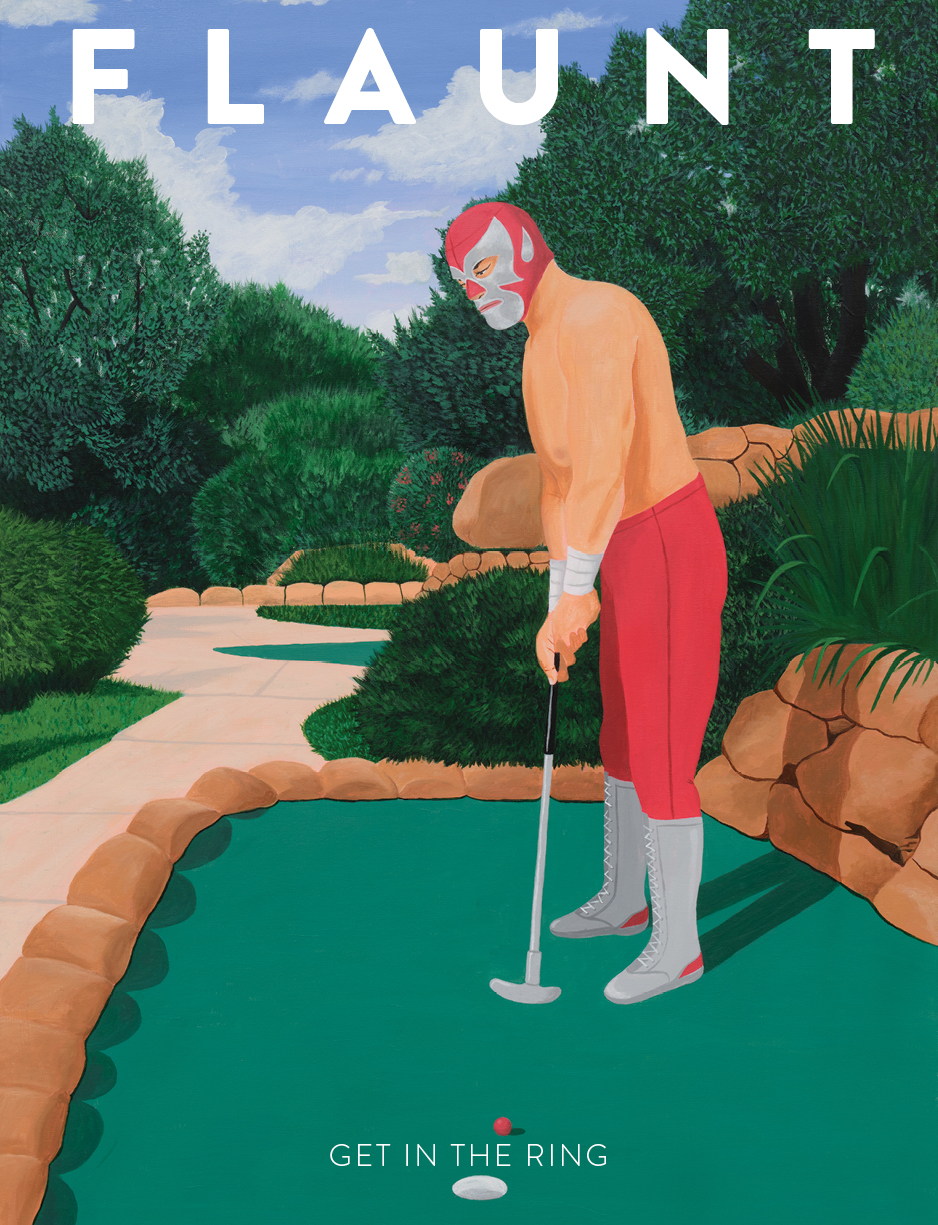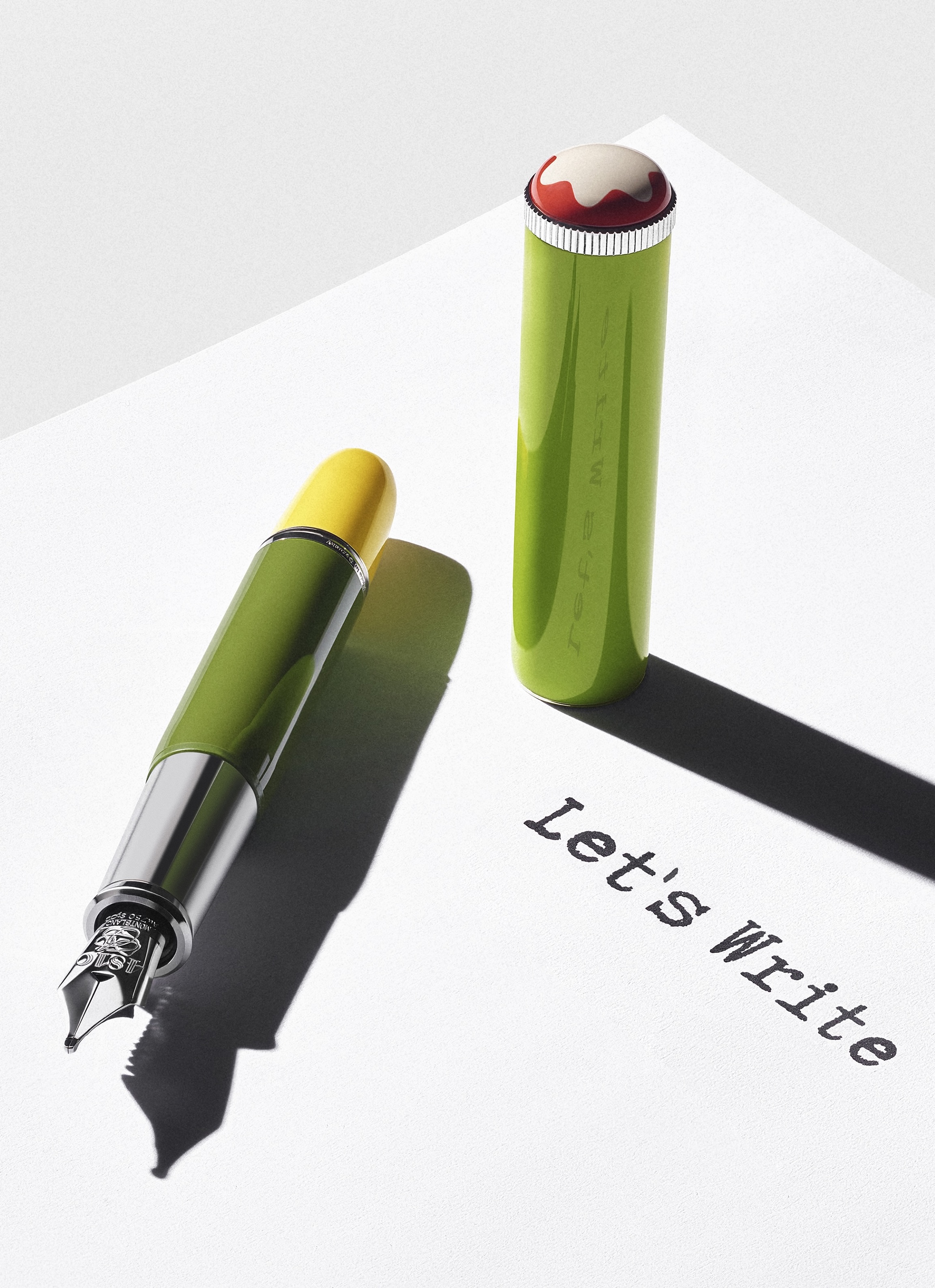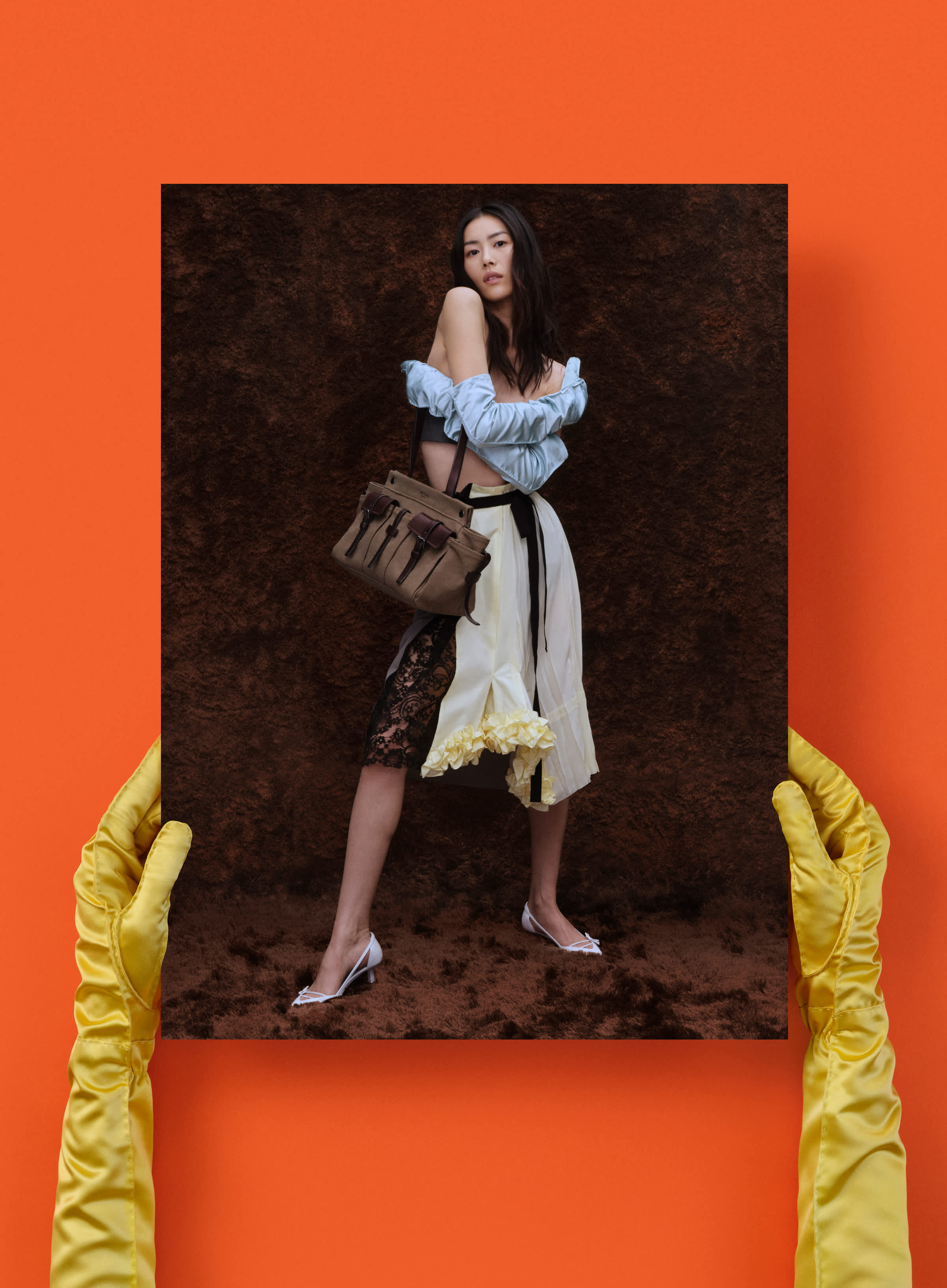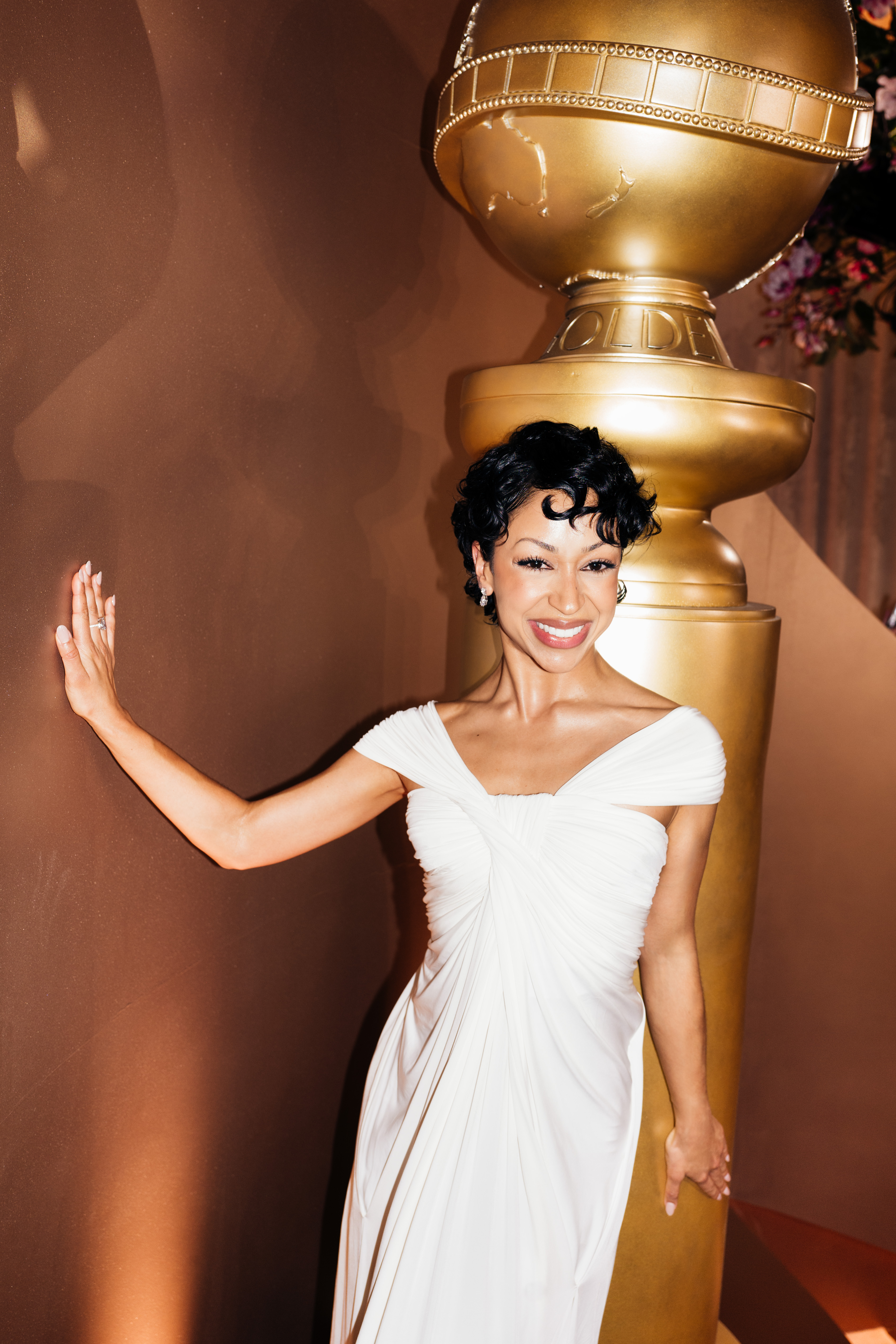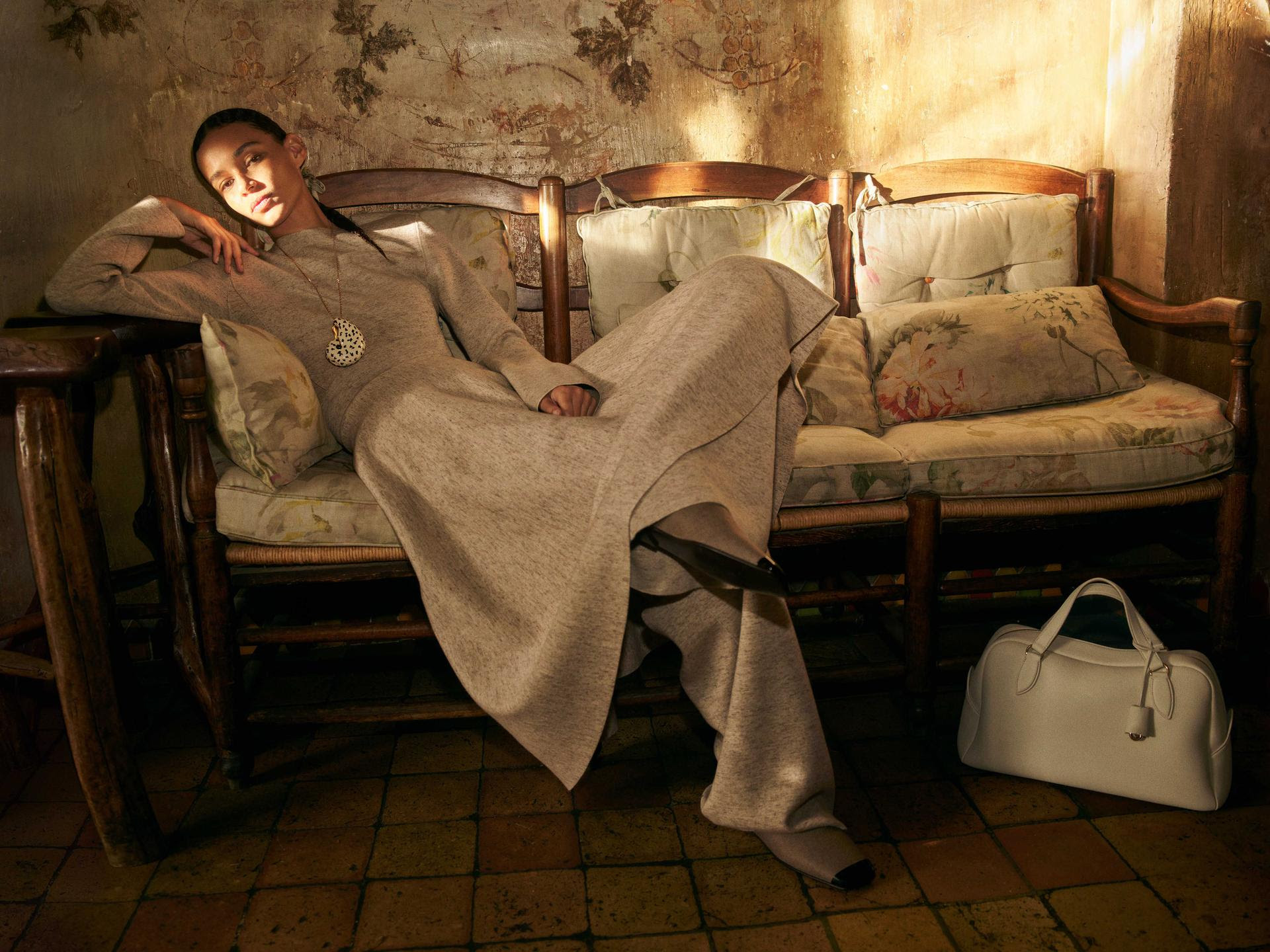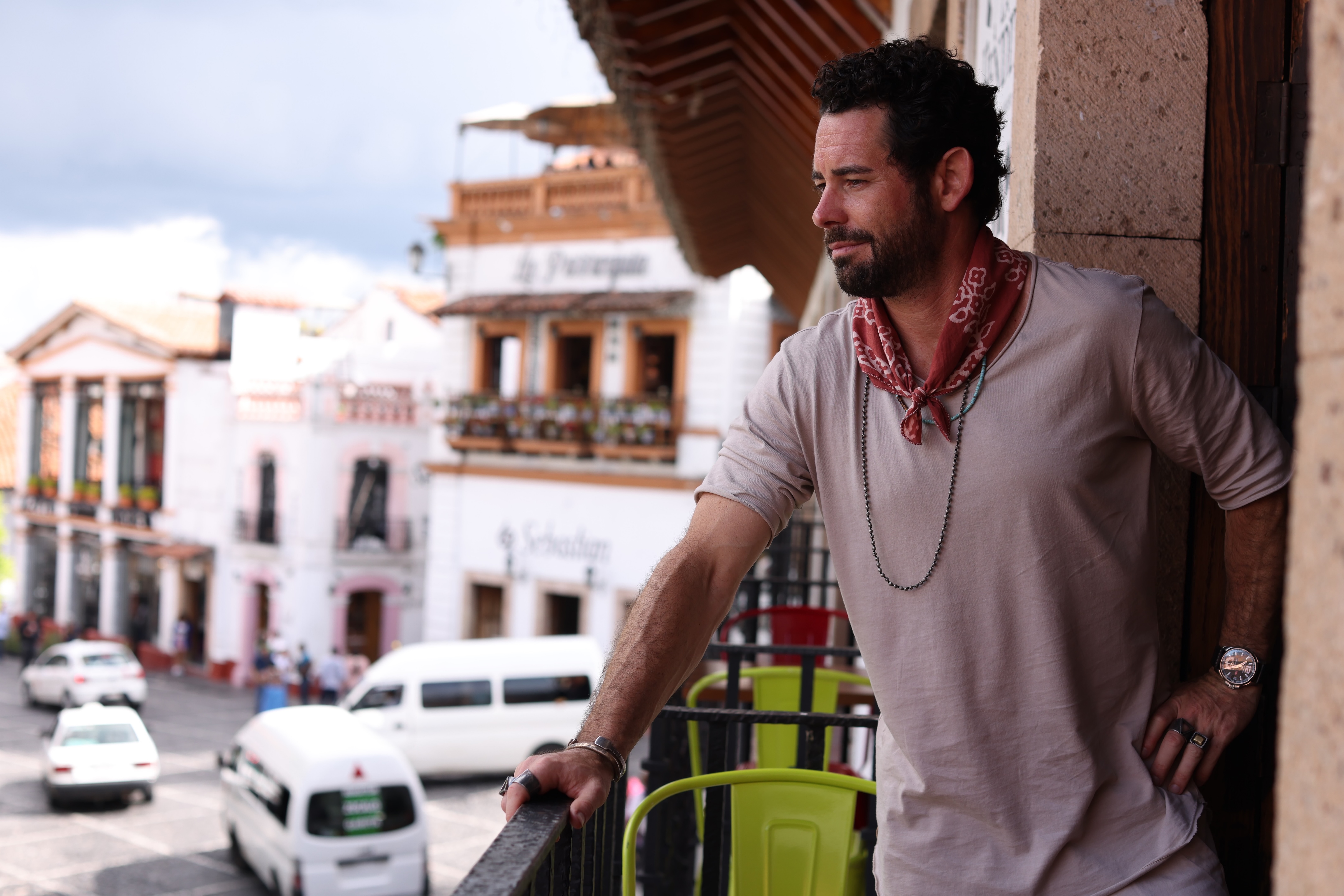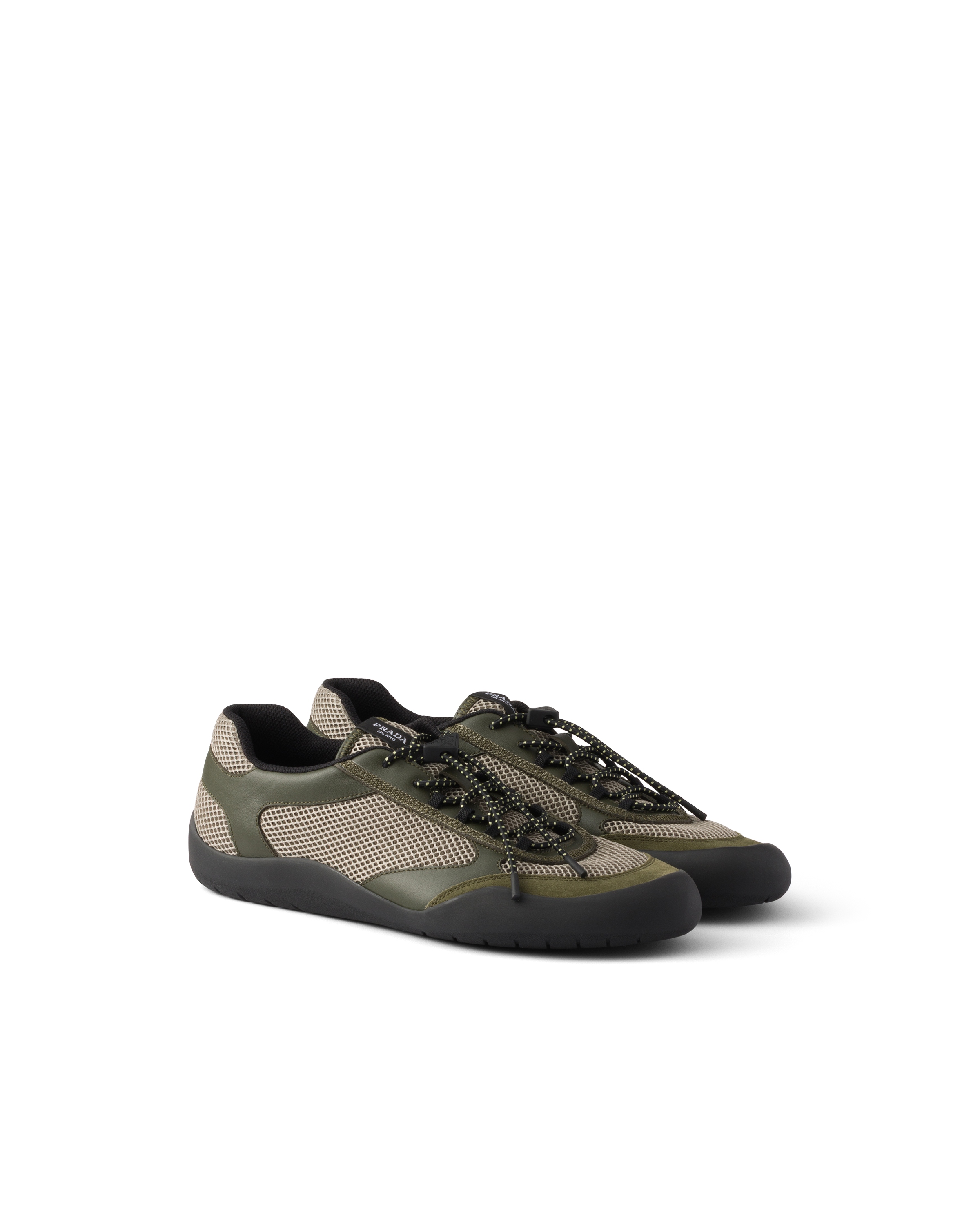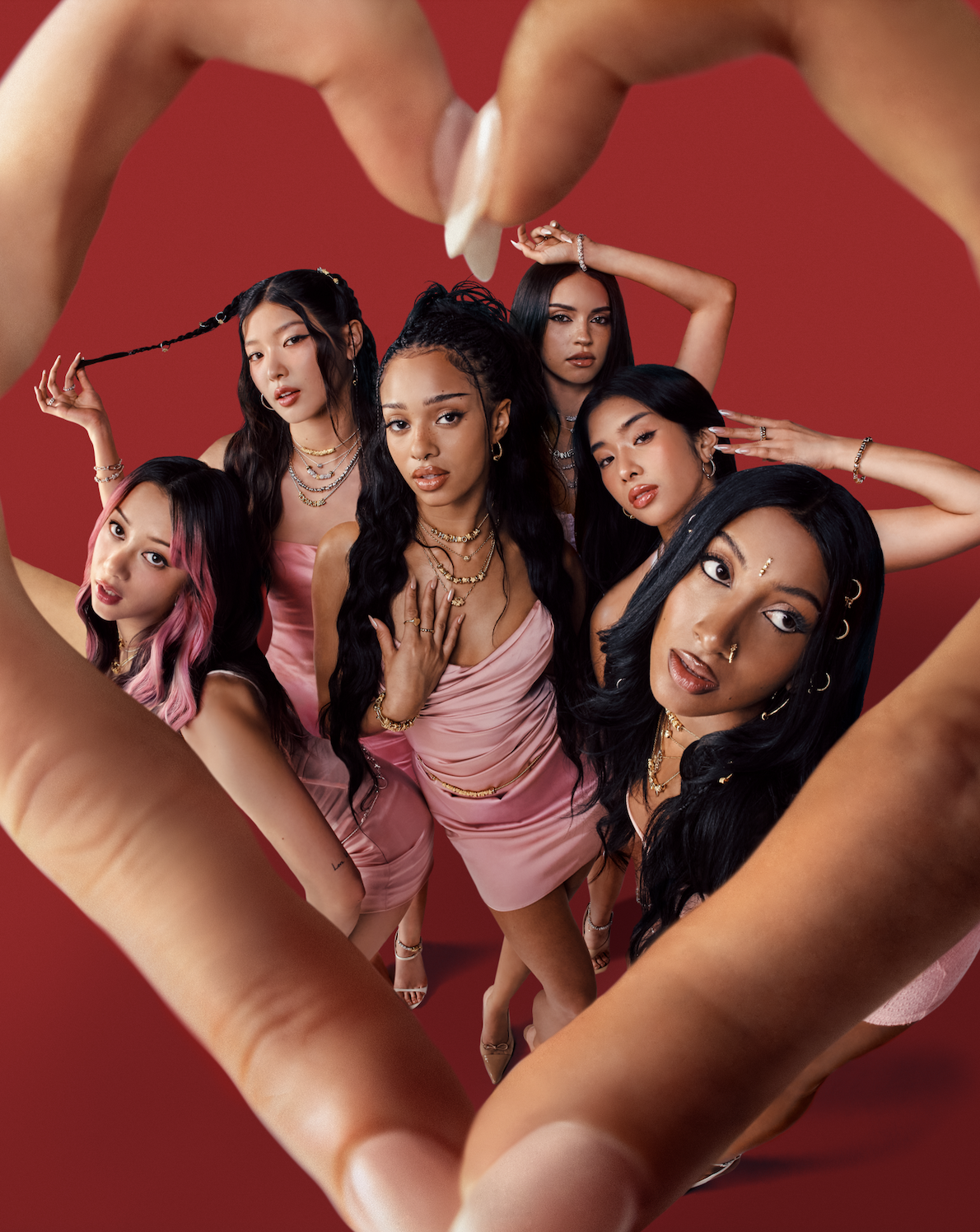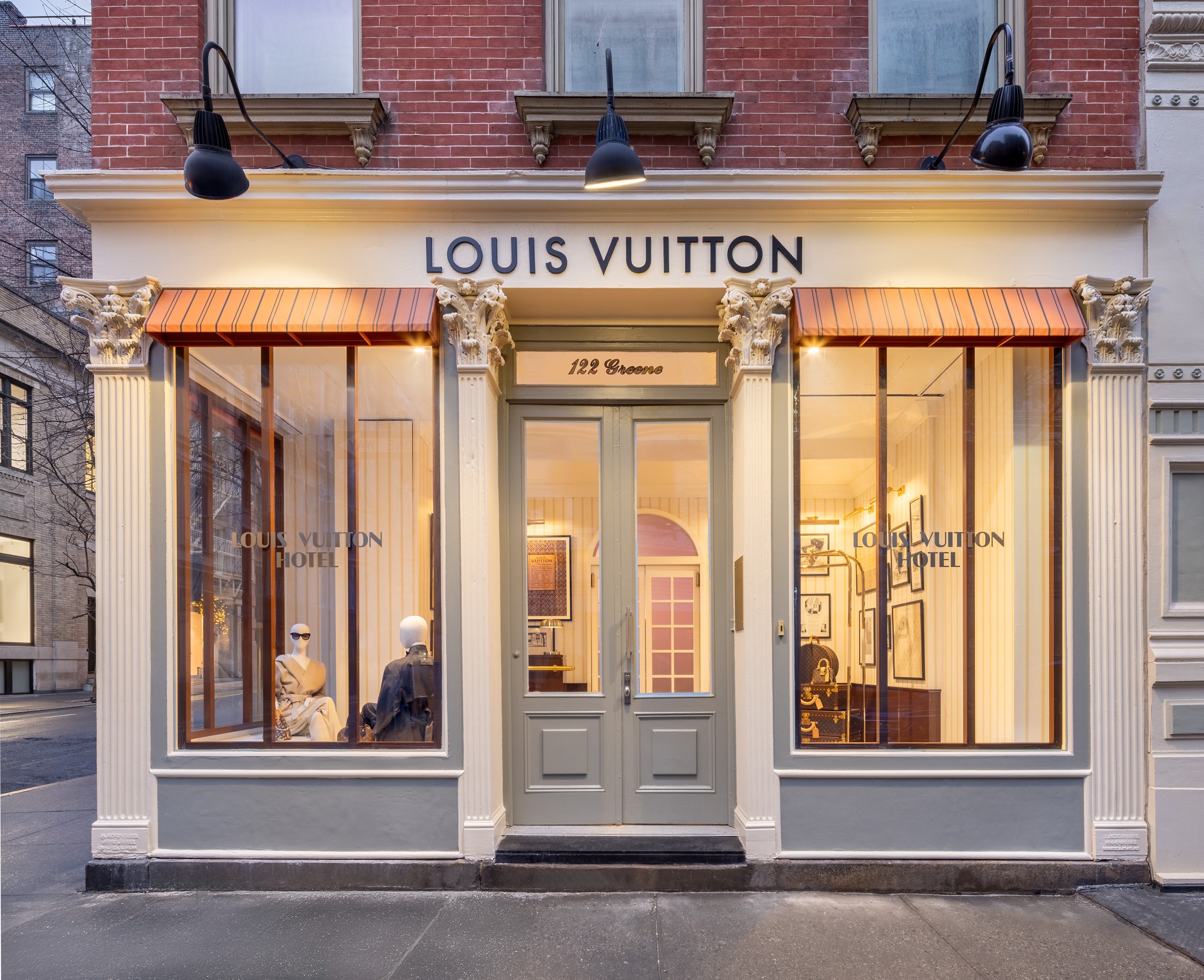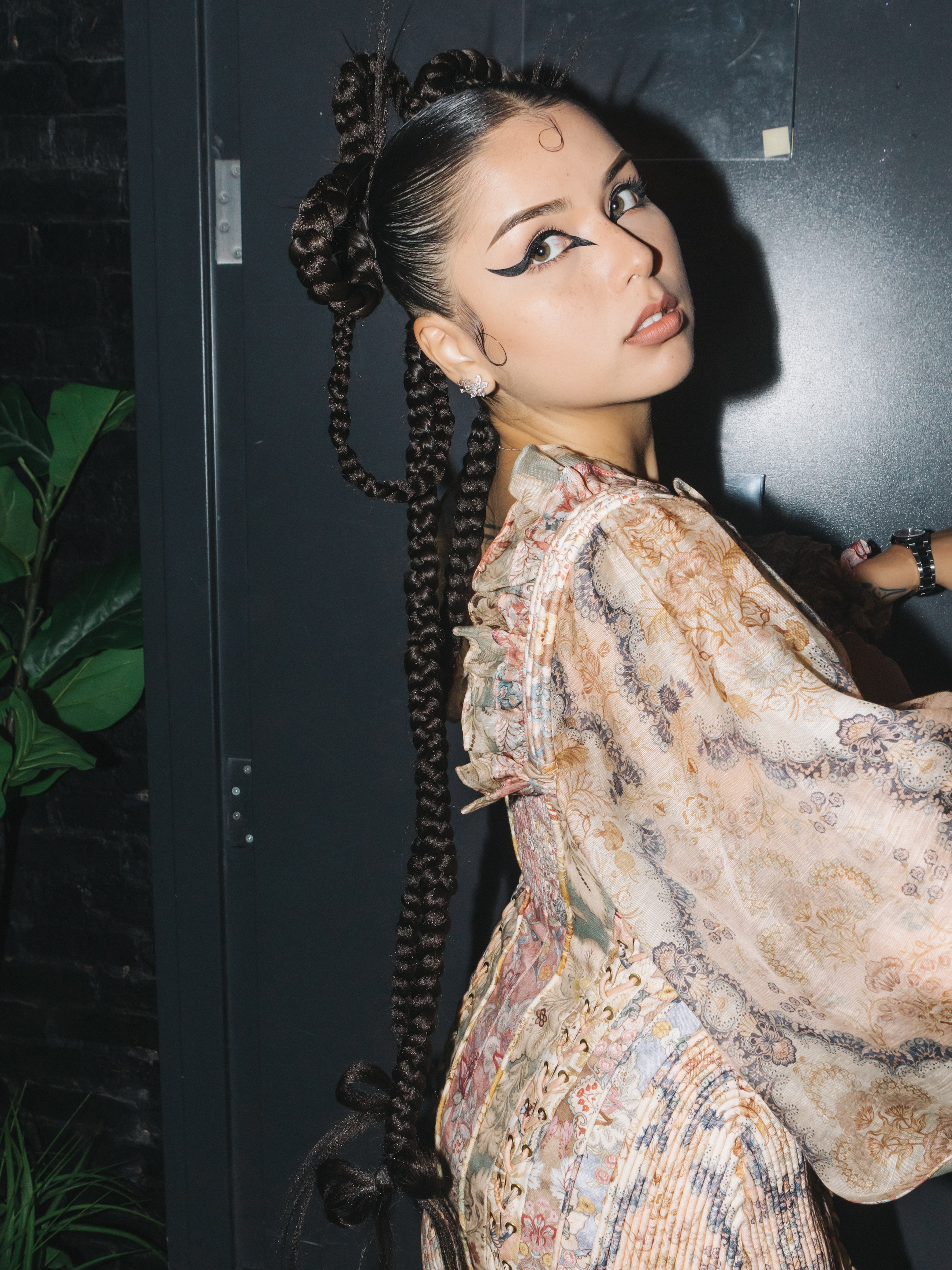

Photo courtesy Catalina Ouyang.
Emilia Yin, art dealer, and gallerist of [Make Room gallery](https://makeroom.la/) in Los Angeles, recently featured the latest works of [Catalina Ouyang](https://catalinaouyang.com/CV). In her confrontation of language, space, and the power relations embedded within them, she created the exhibition “marrow.” Flaunt spoke with both gallerist and artist, decoding the stunning complexity of these works.
**How did the collaboration of 'Marrow' at Make Room gallery transpire?**
**Emilia Yin:** Catalina and I have been working together since the establishment of Make Room. As a millennial myself, I was naturally drawn to the conversations in her practice that reflects our time. Her work discusses the undercurrent of the society we are living in, and constantly poses new questions for one to consider, both visually and conceptually. This is the second solo exhibition that we have worked on together, and it has been a fantastic journey to witness the transformation of Catalina's practice over the past couple of years.
After she graduated from the Yale MFA in May earlier this year, she participated in the Shandaken residency program in New York and the Wilhardt & Naud Residency in LA, where I visited and spoke with her about developing the show together. It was a process where I was able to deepen my understanding of where she stood in her practice and concept behind this show, as well as the stage of life she's in that inspires her to create such a body of work.
As a gallerist myself, I believe that the best I can do is to support her wholeheartedly and provide any emotional support when needed. We worked with the artist and architect Adrian Abela to design and construct a structure of an attic room within one of the gallery spaces, according to Catalina's vision. It was a challenging production, but it turned out really well and brought viewers into another dimension and away from the conventional white cube space.


Catalina Ouyang. _last laugh_. (2019).
**_"Revisionist Storytelling"_ has been used to describe your work. How would you explain this framework?**
**Catalina Ouyang:** I use the term "revisionist" because "reclamation" carries what feels like a false promise, and "feminist" feels fraught and inadequate at this point. That said, I am committed to questions of how to critique—with all of that term's loaded implications—and how to reframe. Storytelling, myth, and folklore are these lush and haunted materials full of potential to be remixed, so as to carry something of a different end from the often violent, patriarchal, and nationalistic forms in which we've inherited them. Sometimes when I think about myths, fairy tales, and stories that have been passed down through generations of oral tradition, I get full-body chills; even though many versions of these narratives have come into being, they each carry the sense that they had to play out the way they did, and there is this sense of timeless doom, the beginning has always been the end. I am not so much interested in beginnings and endings, but in how a story can become a floating, material structure, which you can physically pull from, pollute, fracture, and graft onto other things. A story is a way to introduce constraints, and my project is to explore their inevitability. I prefer to work reductively with a given set of parameters: carving, using found objects weighted with their own histories, drawing from existing stories, and references... I like having something to push against. Working additively freaks me out, it feels too much like playing god — kind of like writing fiction. There's too much you can do.
At the same time, I am not a research-based artist, and my work is not meant to deliver information or enlighten the viewer. I am trying to offer something hazier around the edges. Maybe what I mean is that I deconstruct and fragment stories and that deconstruction entails refusal of the grand narrative. I see that refusal as proposing a kind of righting—and hence becomes a kind of "revision." I don't re-write narratives as a restorative endeavor; there is some kind of power and value to that, certainly, but that's someone else's project. I am interested in colliding signposts to create unstable planes of meaning, thereby gesturing to spaces outside of Universal Reason and scientific knowing. I think about how strategies that have been deployed violently, to patriarchal, imperialist, and capitalist ends—such as extraction, fragmentation, and displacement—can be practiced toward an opposing sensibility. How to wrestle with this stuff until it comes out of a differently-shaped hole? I think—as a secular person raised with no religion—it has to do with faith. And love. Can you love a wretched thing, through sustained touch, into becoming something that carries immanence? Maybe not. But the attempt has to come from the heart.


Catalina Ouyang. _Evil_. (2019).
**In what way does this exhibition confront language, space, and power?**
**_CO:_** We cannot help using the words that we've inherited, but speaking at all often feels like stumbling through a minefield. This analogy, in itself, is obviously militaristic and violent. We inherit these capitalistic and militaristic structures for perceiving and describing the world—we're "invested" in something we care about, we "deploy" methods or skills, we "execute" strategies, we literally "capitalize" on advantageous circumstances, etc. All this language is mired in violence. I sanctioned that sentence in the press release—that my work "confronts" these things—because one must settle for an approximate tool sometimes, but in fact, I really want my work not to "confront" anything. I try to make things in earnest, using available tools that often feel violent, violating, and wrong. English—grammar, at all—is a tool optimized to fortify structures of death, displacement, and suffering. It is also the tool of communication I have at my disposal. Almost everything we touch and use has been created under conditions of violent exploitation. As artists, we muddy our hands by refashioning these things with, for some of us, starry-eyed hopes of overcoming the bloodshed in which they were born. Part of my laughably inadequate response to this is making everything "wrong," in decidedly non-virtuosic and non-archival ways—with cardboard, Styrofoam, plaster, papier-mache, found stuff, food, and garbage. I do carve stone, but I carve it wrong and at the wrong scale, too small and obscured. Much of my work has a precarious relationship to gravity. Often when I start a new piece, I feel as if I am making an object for the first time. By keeping the fabrication strange, unreliable, and in a way unpracticed, I am trying to refuse mastery, and I am trying to keep my tools at a suspicious arm's length.
I've said this a lot, but I used to write, with great ease and alacrity. I was enthusiastic and uncritical about language. For the past several years, I have talked about "when I lost language"—this happened in 2015 after I was raped by a lover, though my rape was ultimately not the sole cause—but in fact, I did not lose language itself, I lost the ease of using language. I lost the abandon. And in hindsight, I am glad to have lost that, because I think it is dangerous to be reckless with language, to feel entitled to it, to feel entitled enough not to question it. The sculptures in marrow feel very much weighed down (or perhaps held up?) by silence. While the video installation last laugh is 22 minutes of incessant language, it is a language that frantically undoes itself. So, there is something about the way that language is either withheld or falls apart completely, in marrow that also feels like a refusal of the tool.


Catalina Ouyang_. crisis management_, (2019).
**What feelings surround the 'crisis management' works?**
**_CO:_** Basically, the four pieces in crisis management came out of a period of pain, confusion, and really spectacular heartbreak that dredged up some old traumas. So, I was hung up on some feelings about being speechless, frozen, without agency, and wanted to process this by thinking very simply about stone, which I had been working with for some time and could never fully make sense of why. How bodies get stoned as punishment (often for sexual or gendered "crimes"), how mythic bodies get turned to stone out of fear or in punishment. Medusa, that old feminist icon, has been a recurring presence in my work, and because of her, I am always coming back to retribution and decapitation.
The pieces are individually titled as follows:
(filling the space with syllables waiting for something to pass)
(invocation of losses counted, suckers had)
(P\[erseus\] came for the holes)
(sometimes all it needs is to be convinced)


Catalina Ouyang. _crisis management,_ (2019).
These titles are meant to allude to some of the narratives I'm drawing from, as well as evoke a sense of time, waiting, and yearning. I was thinking about spaces where we learn how to yearn (and in turn, how to fear and to hate), like the home and the school. Furniture is orientating tools, commensal tools, and disciplinary tools. With the chairs as staging devices, the gesture was quite direct: I knew the chairs must be destroyed and reconstituted, and I wanted them to be quite stark and naked. They had to look really beat up because I wanted the speed and rage of their creation to remain evident.
Thinking about petrification, deep fear, took me to think about trauma and emergency. I don't think of the stone inserts in the faces so much as prosthetics for some kind of lack, as they are a material interruption that brings the heads into a state of transformation. With trauma, there is a breach of such severity that existing mechanisms no longer work—so one is compelled to birth new mechanisms of dealing. The word "emergency" comes from the Latin root emergere, which means to come into being. To be born. In a crisis, there is also genesis. Crisis management, a capitalist term, is the process by which an organization (often a business) responds to a situation that would negatively affect its stakeholders, profitability, reputation, or ability to operate. It's a cynical term. I suppose in using it; I wanted to upend it. While these heads are decapitated and silenced, they are also not without agency; and their necks, at the point of severance, open up into vessels, which are spaces full of potential and nourishment.
To perhaps expand on my answer to your previous question, I was reading an older interview with Paul Preciado where he talks briefly about how sexual subjectivity in the nineteenth century was produced by individuals' movement through a series of institutions such as the family, the factory, the school, the hospital, etc. I began to think about this kind of formative movement through disciplinary space in relation to how Sara Ahmed writes on queer phenomenology, where proprioception is never neutral but deeply impacted by race, gender, sexuality, nationality, etc. And she also takes up the sexual orientation of orientation, the Orientalism of orientation. So, I was thinking about disrupting or inverting a very basic relation a body might have to a social architecture, such as an ass on a chair. These decapitated heads, in their inverted and precarious position, are out-of-sorts, as Ahmed might describe, disorientated. Their woundedness is doubly defeat and insurrection.


Catalina Ouyang_. yoke of thyself_, (2019).
**Tell us about the creation of _"yoke of thyself."_**
**_CO:_** That piece began with a white ribbed tank top—colloquially called a wifebeater, as you probably know. It was the only thing I kept of my ex-lover's, I had thrown away or burned everything else. Honestly, I felt it could be a useful studio garment, and I was working that August in a studio in downtown LA with no AC. So I wore the wifebeater for much of the month and a half that I was making the work for marrow. Maybe a part of me was trying to sweat away the nasty specter of its previous occupant—to drown it out. At a certain point, during that month, I got a tattoo in the center of my back—I tend to get tattoos in times of crisis, sadness, or pain—and the tattoo bled out from its bandage and stained the wifebeater, which I was wearing. It was a small mark, just a purplish-black dot, almost like a freckle on a stretch of the skin, but I was drawn to that as an event of mark-making. I knew after that that I wanted to use this wifebeater in a work somehow, to give it its own death. The wifebeater evokes labor, class, gender, and a specifically fraught domestic space—I kept returning to Marlon Brando in A Streetcar Named Desire—which ties back into ideas around the home and school as conflict zones of punitive learning.
I also recognized, at some point in the making, that I had subliminally been thinking of Jean Rhys' doomed, spectral heroines. _Voyage in the Dark_ and _The Wide Sargasso Sea_ were formative books in my teens. The elliptical quality of her storytelling—all its dissociated, drug-induced gaps in logic and time—was a kind of mirror to ways that negative space and omission operate in my work. _The Wide Sargasso Sea_, of course, offers the "postcolonial" origin story of Antoinette Cosway—known as Bertha Mason in Jane Eyre—whose legacy lives on in flames. The installation last laugh is a nod to her and the Victorian trope of the Madwoman in the Attic. So I really wanted to approach, with a necessary level of abstraction, the pain of the harmed and self-harming body, the pain of inheriting a body irreconcilably marked by and complicit in the violent occupation, the pain of a stripped, flayed, burned skin, hanging from the rafters.
A recurring motif in the show is, of course, that of a head separated from its body, or vice versa. Yoke of thyself is another permutation of that. Once I cut open the garment into this flayed skin, the empty head-hole of the wifebeater suddenly transformed into a belly-hole, and it felt like an orifice full of potential. I thought back to Ursula K. Le Guin's essay "The Carrier Bag Theory of Fiction," in which—speaking of tools, previously—she proposes prehistoric women's work of gathering as an alternative storytelling framework to the phallocentric hero's journey of hunting and killing with sharp objects. In positing the receiving vessel as the first tool, Le Guin makes a case for the unheroic story. I owe the title to a Natalie Diaz poem where she uses the phrase, "yoke of myself," in recounting a moment of coming into self-love—where you learn the value of carrying your own weight and all your traumatic baggage. I liked the idea of the head/belly-hole on this flayed body being purposed into a carrier bag holding significant weight—a pile of stones, which felt appropriately Biblical. I wanted that sack to be visibly straining as if it might not hold up. Honestly, I wasn't sure if it would.


Catalina Ouyang_. crisis management_ (detail), (2019).
* * *
Images courtesy of Make Room Los Angeles and the artist, photographed by Yubo Dong and Make Room Los Angeles.
 
Photo courtesy Catalina Ouyang.
Emilia Yin, art dealer, and gallerist of [Make Room gallery](https://makeroom.la/) in Los Angeles, recently featured the latest works of [Catalina Ouyang](https://catalinaouyang.com/CV). In her confrontation of language, space, and the power relations embedded within them, she created the exhibition “marrow.” Flaunt spoke with both gallerist and artist, decoding the stunning complexity of these works.
**How did the collaboration of 'Marrow' at Make Room gallery transpire?**
**Emilia Yin:** Catalina and I have been working together since the establishment of Make Room. As a millennial myself, I was naturally drawn to the conversations in her practice that reflects our time. Her work discusses the undercurrent of the society we are living in, and constantly poses new questions for one to consider, both visually and conceptually. This is the second solo exhibition that we have worked on together, and it has been a fantastic journey to witness the transformation of Catalina's practice over the past couple of years.
After she graduated from the Yale MFA in May earlier this year, she participated in the Shandaken residency program in New York and the Wilhardt & Naud Residency in LA, where I visited and spoke with her about developing the show together. It was a process where I was able to deepen my understanding of where she stood in her practice and concept behind this show, as well as the stage of life she's in that inspires her to create such a body of work.
As a gallerist myself, I believe that the best I can do is to support her wholeheartedly and provide any emotional support when needed. We worked with the artist and architect Adrian Abela to design and construct a structure of an attic room within one of the gallery spaces, according to Catalina's vision. It was a challenging production, but it turned out really well and brought viewers into another dimension and away from the conventional white cube space.

Photo courtesy Catalina Ouyang.
Emilia Yin, art dealer, and gallerist of [Make Room gallery](https://makeroom.la/) in Los Angeles, recently featured the latest works of [Catalina Ouyang](https://catalinaouyang.com/CV). In her confrontation of language, space, and the power relations embedded within them, she created the exhibition “marrow.” Flaunt spoke with both gallerist and artist, decoding the stunning complexity of these works.
**How did the collaboration of 'Marrow' at Make Room gallery transpire?**
**Emilia Yin:** Catalina and I have been working together since the establishment of Make Room. As a millennial myself, I was naturally drawn to the conversations in her practice that reflects our time. Her work discusses the undercurrent of the society we are living in, and constantly poses new questions for one to consider, both visually and conceptually. This is the second solo exhibition that we have worked on together, and it has been a fantastic journey to witness the transformation of Catalina's practice over the past couple of years.
After she graduated from the Yale MFA in May earlier this year, she participated in the Shandaken residency program in New York and the Wilhardt & Naud Residency in LA, where I visited and spoke with her about developing the show together. It was a process where I was able to deepen my understanding of where she stood in her practice and concept behind this show, as well as the stage of life she's in that inspires her to create such a body of work.
As a gallerist myself, I believe that the best I can do is to support her wholeheartedly and provide any emotional support when needed. We worked with the artist and architect Adrian Abela to design and construct a structure of an attic room within one of the gallery spaces, according to Catalina's vision. It was a challenging production, but it turned out really well and brought viewers into another dimension and away from the conventional white cube space.
 
Catalina Ouyang. _last laugh_. (2019).
**_"Revisionist Storytelling"_ has been used to describe your work. How would you explain this framework?**
**Catalina Ouyang:** I use the term "revisionist" because "reclamation" carries what feels like a false promise, and "feminist" feels fraught and inadequate at this point. That said, I am committed to questions of how to critique—with all of that term's loaded implications—and how to reframe. Storytelling, myth, and folklore are these lush and haunted materials full of potential to be remixed, so as to carry something of a different end from the often violent, patriarchal, and nationalistic forms in which we've inherited them. Sometimes when I think about myths, fairy tales, and stories that have been passed down through generations of oral tradition, I get full-body chills; even though many versions of these narratives have come into being, they each carry the sense that they had to play out the way they did, and there is this sense of timeless doom, the beginning has always been the end. I am not so much interested in beginnings and endings, but in how a story can become a floating, material structure, which you can physically pull from, pollute, fracture, and graft onto other things. A story is a way to introduce constraints, and my project is to explore their inevitability. I prefer to work reductively with a given set of parameters: carving, using found objects weighted with their own histories, drawing from existing stories, and references... I like having something to push against. Working additively freaks me out, it feels too much like playing god — kind of like writing fiction. There's too much you can do.
At the same time, I am not a research-based artist, and my work is not meant to deliver information or enlighten the viewer. I am trying to offer something hazier around the edges. Maybe what I mean is that I deconstruct and fragment stories and that deconstruction entails refusal of the grand narrative. I see that refusal as proposing a kind of righting—and hence becomes a kind of "revision." I don't re-write narratives as a restorative endeavor; there is some kind of power and value to that, certainly, but that's someone else's project. I am interested in colliding signposts to create unstable planes of meaning, thereby gesturing to spaces outside of Universal Reason and scientific knowing. I think about how strategies that have been deployed violently, to patriarchal, imperialist, and capitalist ends—such as extraction, fragmentation, and displacement—can be practiced toward an opposing sensibility. How to wrestle with this stuff until it comes out of a differently-shaped hole? I think—as a secular person raised with no religion—it has to do with faith. And love. Can you love a wretched thing, through sustained touch, into becoming something that carries immanence? Maybe not. But the attempt has to come from the heart.

Catalina Ouyang. _last laugh_. (2019).
**_"Revisionist Storytelling"_ has been used to describe your work. How would you explain this framework?**
**Catalina Ouyang:** I use the term "revisionist" because "reclamation" carries what feels like a false promise, and "feminist" feels fraught and inadequate at this point. That said, I am committed to questions of how to critique—with all of that term's loaded implications—and how to reframe. Storytelling, myth, and folklore are these lush and haunted materials full of potential to be remixed, so as to carry something of a different end from the often violent, patriarchal, and nationalistic forms in which we've inherited them. Sometimes when I think about myths, fairy tales, and stories that have been passed down through generations of oral tradition, I get full-body chills; even though many versions of these narratives have come into being, they each carry the sense that they had to play out the way they did, and there is this sense of timeless doom, the beginning has always been the end. I am not so much interested in beginnings and endings, but in how a story can become a floating, material structure, which you can physically pull from, pollute, fracture, and graft onto other things. A story is a way to introduce constraints, and my project is to explore their inevitability. I prefer to work reductively with a given set of parameters: carving, using found objects weighted with their own histories, drawing from existing stories, and references... I like having something to push against. Working additively freaks me out, it feels too much like playing god — kind of like writing fiction. There's too much you can do.
At the same time, I am not a research-based artist, and my work is not meant to deliver information or enlighten the viewer. I am trying to offer something hazier around the edges. Maybe what I mean is that I deconstruct and fragment stories and that deconstruction entails refusal of the grand narrative. I see that refusal as proposing a kind of righting—and hence becomes a kind of "revision." I don't re-write narratives as a restorative endeavor; there is some kind of power and value to that, certainly, but that's someone else's project. I am interested in colliding signposts to create unstable planes of meaning, thereby gesturing to spaces outside of Universal Reason and scientific knowing. I think about how strategies that have been deployed violently, to patriarchal, imperialist, and capitalist ends—such as extraction, fragmentation, and displacement—can be practiced toward an opposing sensibility. How to wrestle with this stuff until it comes out of a differently-shaped hole? I think—as a secular person raised with no religion—it has to do with faith. And love. Can you love a wretched thing, through sustained touch, into becoming something that carries immanence? Maybe not. But the attempt has to come from the heart.
 
Catalina Ouyang. _Evil_. (2019).
**In what way does this exhibition confront language, space, and power?**
**_CO:_** We cannot help using the words that we've inherited, but speaking at all often feels like stumbling through a minefield. This analogy, in itself, is obviously militaristic and violent. We inherit these capitalistic and militaristic structures for perceiving and describing the world—we're "invested" in something we care about, we "deploy" methods or skills, we "execute" strategies, we literally "capitalize" on advantageous circumstances, etc. All this language is mired in violence. I sanctioned that sentence in the press release—that my work "confronts" these things—because one must settle for an approximate tool sometimes, but in fact, I really want my work not to "confront" anything. I try to make things in earnest, using available tools that often feel violent, violating, and wrong. English—grammar, at all—is a tool optimized to fortify structures of death, displacement, and suffering. It is also the tool of communication I have at my disposal. Almost everything we touch and use has been created under conditions of violent exploitation. As artists, we muddy our hands by refashioning these things with, for some of us, starry-eyed hopes of overcoming the bloodshed in which they were born. Part of my laughably inadequate response to this is making everything "wrong," in decidedly non-virtuosic and non-archival ways—with cardboard, Styrofoam, plaster, papier-mache, found stuff, food, and garbage. I do carve stone, but I carve it wrong and at the wrong scale, too small and obscured. Much of my work has a precarious relationship to gravity. Often when I start a new piece, I feel as if I am making an object for the first time. By keeping the fabrication strange, unreliable, and in a way unpracticed, I am trying to refuse mastery, and I am trying to keep my tools at a suspicious arm's length.
I've said this a lot, but I used to write, with great ease and alacrity. I was enthusiastic and uncritical about language. For the past several years, I have talked about "when I lost language"—this happened in 2015 after I was raped by a lover, though my rape was ultimately not the sole cause—but in fact, I did not lose language itself, I lost the ease of using language. I lost the abandon. And in hindsight, I am glad to have lost that, because I think it is dangerous to be reckless with language, to feel entitled to it, to feel entitled enough not to question it. The sculptures in marrow feel very much weighed down (or perhaps held up?) by silence. While the video installation last laugh is 22 minutes of incessant language, it is a language that frantically undoes itself. So, there is something about the way that language is either withheld or falls apart completely, in marrow that also feels like a refusal of the tool.

Catalina Ouyang. _Evil_. (2019).
**In what way does this exhibition confront language, space, and power?**
**_CO:_** We cannot help using the words that we've inherited, but speaking at all often feels like stumbling through a minefield. This analogy, in itself, is obviously militaristic and violent. We inherit these capitalistic and militaristic structures for perceiving and describing the world—we're "invested" in something we care about, we "deploy" methods or skills, we "execute" strategies, we literally "capitalize" on advantageous circumstances, etc. All this language is mired in violence. I sanctioned that sentence in the press release—that my work "confronts" these things—because one must settle for an approximate tool sometimes, but in fact, I really want my work not to "confront" anything. I try to make things in earnest, using available tools that often feel violent, violating, and wrong. English—grammar, at all—is a tool optimized to fortify structures of death, displacement, and suffering. It is also the tool of communication I have at my disposal. Almost everything we touch and use has been created under conditions of violent exploitation. As artists, we muddy our hands by refashioning these things with, for some of us, starry-eyed hopes of overcoming the bloodshed in which they were born. Part of my laughably inadequate response to this is making everything "wrong," in decidedly non-virtuosic and non-archival ways—with cardboard, Styrofoam, plaster, papier-mache, found stuff, food, and garbage. I do carve stone, but I carve it wrong and at the wrong scale, too small and obscured. Much of my work has a precarious relationship to gravity. Often when I start a new piece, I feel as if I am making an object for the first time. By keeping the fabrication strange, unreliable, and in a way unpracticed, I am trying to refuse mastery, and I am trying to keep my tools at a suspicious arm's length.
I've said this a lot, but I used to write, with great ease and alacrity. I was enthusiastic and uncritical about language. For the past several years, I have talked about "when I lost language"—this happened in 2015 after I was raped by a lover, though my rape was ultimately not the sole cause—but in fact, I did not lose language itself, I lost the ease of using language. I lost the abandon. And in hindsight, I am glad to have lost that, because I think it is dangerous to be reckless with language, to feel entitled to it, to feel entitled enough not to question it. The sculptures in marrow feel very much weighed down (or perhaps held up?) by silence. While the video installation last laugh is 22 minutes of incessant language, it is a language that frantically undoes itself. So, there is something about the way that language is either withheld or falls apart completely, in marrow that also feels like a refusal of the tool.
 
Catalina Ouyang_. crisis management_, (2019).
**What feelings surround the 'crisis management' works?**
**_CO:_** Basically, the four pieces in crisis management came out of a period of pain, confusion, and really spectacular heartbreak that dredged up some old traumas. So, I was hung up on some feelings about being speechless, frozen, without agency, and wanted to process this by thinking very simply about stone, which I had been working with for some time and could never fully make sense of why. How bodies get stoned as punishment (often for sexual or gendered "crimes"), how mythic bodies get turned to stone out of fear or in punishment. Medusa, that old feminist icon, has been a recurring presence in my work, and because of her, I am always coming back to retribution and decapitation.
The pieces are individually titled as follows:
(filling the space with syllables waiting for something to pass)
(invocation of losses counted, suckers had)
(P\[erseus\] came for the holes)
(sometimes all it needs is to be convinced)

Catalina Ouyang_. crisis management_, (2019).
**What feelings surround the 'crisis management' works?**
**_CO:_** Basically, the four pieces in crisis management came out of a period of pain, confusion, and really spectacular heartbreak that dredged up some old traumas. So, I was hung up on some feelings about being speechless, frozen, without agency, and wanted to process this by thinking very simply about stone, which I had been working with for some time and could never fully make sense of why. How bodies get stoned as punishment (often for sexual or gendered "crimes"), how mythic bodies get turned to stone out of fear or in punishment. Medusa, that old feminist icon, has been a recurring presence in my work, and because of her, I am always coming back to retribution and decapitation.
The pieces are individually titled as follows:
(filling the space with syllables waiting for something to pass)
(invocation of losses counted, suckers had)
(P\[erseus\] came for the holes)
(sometimes all it needs is to be convinced)
 
Catalina Ouyang. _crisis management,_ (2019).
These titles are meant to allude to some of the narratives I'm drawing from, as well as evoke a sense of time, waiting, and yearning. I was thinking about spaces where we learn how to yearn (and in turn, how to fear and to hate), like the home and the school. Furniture is orientating tools, commensal tools, and disciplinary tools. With the chairs as staging devices, the gesture was quite direct: I knew the chairs must be destroyed and reconstituted, and I wanted them to be quite stark and naked. They had to look really beat up because I wanted the speed and rage of their creation to remain evident.
Thinking about petrification, deep fear, took me to think about trauma and emergency. I don't think of the stone inserts in the faces so much as prosthetics for some kind of lack, as they are a material interruption that brings the heads into a state of transformation. With trauma, there is a breach of such severity that existing mechanisms no longer work—so one is compelled to birth new mechanisms of dealing. The word "emergency" comes from the Latin root emergere, which means to come into being. To be born. In a crisis, there is also genesis. Crisis management, a capitalist term, is the process by which an organization (often a business) responds to a situation that would negatively affect its stakeholders, profitability, reputation, or ability to operate. It's a cynical term. I suppose in using it; I wanted to upend it. While these heads are decapitated and silenced, they are also not without agency; and their necks, at the point of severance, open up into vessels, which are spaces full of potential and nourishment.
To perhaps expand on my answer to your previous question, I was reading an older interview with Paul Preciado where he talks briefly about how sexual subjectivity in the nineteenth century was produced by individuals' movement through a series of institutions such as the family, the factory, the school, the hospital, etc. I began to think about this kind of formative movement through disciplinary space in relation to how Sara Ahmed writes on queer phenomenology, where proprioception is never neutral but deeply impacted by race, gender, sexuality, nationality, etc. And she also takes up the sexual orientation of orientation, the Orientalism of orientation. So, I was thinking about disrupting or inverting a very basic relation a body might have to a social architecture, such as an ass on a chair. These decapitated heads, in their inverted and precarious position, are out-of-sorts, as Ahmed might describe, disorientated. Their woundedness is doubly defeat and insurrection.

Catalina Ouyang. _crisis management,_ (2019).
These titles are meant to allude to some of the narratives I'm drawing from, as well as evoke a sense of time, waiting, and yearning. I was thinking about spaces where we learn how to yearn (and in turn, how to fear and to hate), like the home and the school. Furniture is orientating tools, commensal tools, and disciplinary tools. With the chairs as staging devices, the gesture was quite direct: I knew the chairs must be destroyed and reconstituted, and I wanted them to be quite stark and naked. They had to look really beat up because I wanted the speed and rage of their creation to remain evident.
Thinking about petrification, deep fear, took me to think about trauma and emergency. I don't think of the stone inserts in the faces so much as prosthetics for some kind of lack, as they are a material interruption that brings the heads into a state of transformation. With trauma, there is a breach of such severity that existing mechanisms no longer work—so one is compelled to birth new mechanisms of dealing. The word "emergency" comes from the Latin root emergere, which means to come into being. To be born. In a crisis, there is also genesis. Crisis management, a capitalist term, is the process by which an organization (often a business) responds to a situation that would negatively affect its stakeholders, profitability, reputation, or ability to operate. It's a cynical term. I suppose in using it; I wanted to upend it. While these heads are decapitated and silenced, they are also not without agency; and their necks, at the point of severance, open up into vessels, which are spaces full of potential and nourishment.
To perhaps expand on my answer to your previous question, I was reading an older interview with Paul Preciado where he talks briefly about how sexual subjectivity in the nineteenth century was produced by individuals' movement through a series of institutions such as the family, the factory, the school, the hospital, etc. I began to think about this kind of formative movement through disciplinary space in relation to how Sara Ahmed writes on queer phenomenology, where proprioception is never neutral but deeply impacted by race, gender, sexuality, nationality, etc. And she also takes up the sexual orientation of orientation, the Orientalism of orientation. So, I was thinking about disrupting or inverting a very basic relation a body might have to a social architecture, such as an ass on a chair. These decapitated heads, in their inverted and precarious position, are out-of-sorts, as Ahmed might describe, disorientated. Their woundedness is doubly defeat and insurrection.
 
Catalina Ouyang_. yoke of thyself_, (2019).
**Tell us about the creation of _"yoke of thyself."_**
**_CO:_** That piece began with a white ribbed tank top—colloquially called a wifebeater, as you probably know. It was the only thing I kept of my ex-lover's, I had thrown away or burned everything else. Honestly, I felt it could be a useful studio garment, and I was working that August in a studio in downtown LA with no AC. So I wore the wifebeater for much of the month and a half that I was making the work for marrow. Maybe a part of me was trying to sweat away the nasty specter of its previous occupant—to drown it out. At a certain point, during that month, I got a tattoo in the center of my back—I tend to get tattoos in times of crisis, sadness, or pain—and the tattoo bled out from its bandage and stained the wifebeater, which I was wearing. It was a small mark, just a purplish-black dot, almost like a freckle on a stretch of the skin, but I was drawn to that as an event of mark-making. I knew after that that I wanted to use this wifebeater in a work somehow, to give it its own death. The wifebeater evokes labor, class, gender, and a specifically fraught domestic space—I kept returning to Marlon Brando in A Streetcar Named Desire—which ties back into ideas around the home and school as conflict zones of punitive learning.
I also recognized, at some point in the making, that I had subliminally been thinking of Jean Rhys' doomed, spectral heroines. _Voyage in the Dark_ and _The Wide Sargasso Sea_ were formative books in my teens. The elliptical quality of her storytelling—all its dissociated, drug-induced gaps in logic and time—was a kind of mirror to ways that negative space and omission operate in my work. _The Wide Sargasso Sea_, of course, offers the "postcolonial" origin story of Antoinette Cosway—known as Bertha Mason in Jane Eyre—whose legacy lives on in flames. The installation last laugh is a nod to her and the Victorian trope of the Madwoman in the Attic. So I really wanted to approach, with a necessary level of abstraction, the pain of the harmed and self-harming body, the pain of inheriting a body irreconcilably marked by and complicit in the violent occupation, the pain of a stripped, flayed, burned skin, hanging from the rafters.
A recurring motif in the show is, of course, that of a head separated from its body, or vice versa. Yoke of thyself is another permutation of that. Once I cut open the garment into this flayed skin, the empty head-hole of the wifebeater suddenly transformed into a belly-hole, and it felt like an orifice full of potential. I thought back to Ursula K. Le Guin's essay "The Carrier Bag Theory of Fiction," in which—speaking of tools, previously—she proposes prehistoric women's work of gathering as an alternative storytelling framework to the phallocentric hero's journey of hunting and killing with sharp objects. In positing the receiving vessel as the first tool, Le Guin makes a case for the unheroic story. I owe the title to a Natalie Diaz poem where she uses the phrase, "yoke of myself," in recounting a moment of coming into self-love—where you learn the value of carrying your own weight and all your traumatic baggage. I liked the idea of the head/belly-hole on this flayed body being purposed into a carrier bag holding significant weight—a pile of stones, which felt appropriately Biblical. I wanted that sack to be visibly straining as if it might not hold up. Honestly, I wasn't sure if it would.

Catalina Ouyang_. yoke of thyself_, (2019).
**Tell us about the creation of _"yoke of thyself."_**
**_CO:_** That piece began with a white ribbed tank top—colloquially called a wifebeater, as you probably know. It was the only thing I kept of my ex-lover's, I had thrown away or burned everything else. Honestly, I felt it could be a useful studio garment, and I was working that August in a studio in downtown LA with no AC. So I wore the wifebeater for much of the month and a half that I was making the work for marrow. Maybe a part of me was trying to sweat away the nasty specter of its previous occupant—to drown it out. At a certain point, during that month, I got a tattoo in the center of my back—I tend to get tattoos in times of crisis, sadness, or pain—and the tattoo bled out from its bandage and stained the wifebeater, which I was wearing. It was a small mark, just a purplish-black dot, almost like a freckle on a stretch of the skin, but I was drawn to that as an event of mark-making. I knew after that that I wanted to use this wifebeater in a work somehow, to give it its own death. The wifebeater evokes labor, class, gender, and a specifically fraught domestic space—I kept returning to Marlon Brando in A Streetcar Named Desire—which ties back into ideas around the home and school as conflict zones of punitive learning.
I also recognized, at some point in the making, that I had subliminally been thinking of Jean Rhys' doomed, spectral heroines. _Voyage in the Dark_ and _The Wide Sargasso Sea_ were formative books in my teens. The elliptical quality of her storytelling—all its dissociated, drug-induced gaps in logic and time—was a kind of mirror to ways that negative space and omission operate in my work. _The Wide Sargasso Sea_, of course, offers the "postcolonial" origin story of Antoinette Cosway—known as Bertha Mason in Jane Eyre—whose legacy lives on in flames. The installation last laugh is a nod to her and the Victorian trope of the Madwoman in the Attic. So I really wanted to approach, with a necessary level of abstraction, the pain of the harmed and self-harming body, the pain of inheriting a body irreconcilably marked by and complicit in the violent occupation, the pain of a stripped, flayed, burned skin, hanging from the rafters.
A recurring motif in the show is, of course, that of a head separated from its body, or vice versa. Yoke of thyself is another permutation of that. Once I cut open the garment into this flayed skin, the empty head-hole of the wifebeater suddenly transformed into a belly-hole, and it felt like an orifice full of potential. I thought back to Ursula K. Le Guin's essay "The Carrier Bag Theory of Fiction," in which—speaking of tools, previously—she proposes prehistoric women's work of gathering as an alternative storytelling framework to the phallocentric hero's journey of hunting and killing with sharp objects. In positing the receiving vessel as the first tool, Le Guin makes a case for the unheroic story. I owe the title to a Natalie Diaz poem where she uses the phrase, "yoke of myself," in recounting a moment of coming into self-love—where you learn the value of carrying your own weight and all your traumatic baggage. I liked the idea of the head/belly-hole on this flayed body being purposed into a carrier bag holding significant weight—a pile of stones, which felt appropriately Biblical. I wanted that sack to be visibly straining as if it might not hold up. Honestly, I wasn't sure if it would.
 
Catalina Ouyang_. crisis management_ (detail), (2019).
* * *
Images courtesy of Make Room Los Angeles and the artist, photographed by Yubo Dong and Make Room Los Angeles.

Catalina Ouyang_. crisis management_ (detail), (2019).
* * *
Images courtesy of Make Room Los Angeles and the artist, photographed by Yubo Dong and Make Room Los Angeles.
